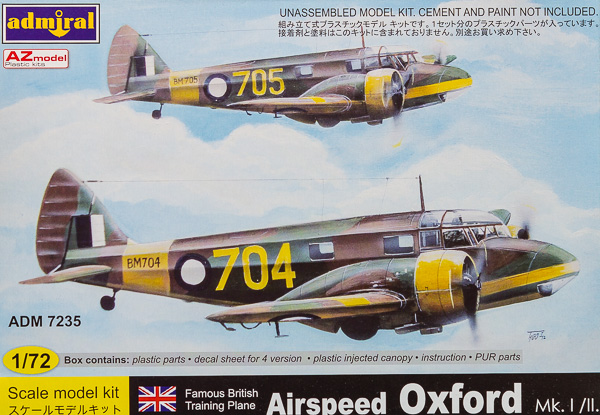
Admiral 1/72 Airspeed Oxford Mk. I/II
By Chris Banyai-Riepl
Overview
With the rapid growth of the RAF's Bomber Command throughout the 1930s, the need for a good advanced trainer quickly came to the forefront. The result was the Airspeed Oxford, a solid twin-engined aircraft based on their commercial AS.6 Envoy aircraft. The first prototype flew on June 19, 1937, and well over 8,000 were built by several factories throughout the war.
The Kit
Admiral's kit of the Airspeed Oxford is typical of short-run Czech kits these days, molded in medium gray plastic, with recessed panel lines and subtle fabric detail. The clear parts are injection-molded, and a small bag of resin details provides additional parts that are best replicated in that medium. The decal sheet provides markings for four aircraft from around the world.
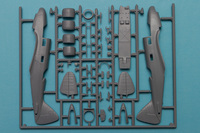 Stepping into the build, the first step is to tackle the interior. As the Oxford was based off an eight-place commercial aircraft, there is quite a bit of space in the cabin. This is filled with a large one-piece floor, with a separate rear bulkhead piece, a center block for over the wing spar, and a cockpit that has a separate instrument panel, separate control columns, and separate rudder pedals. The seats are provided in resin, as are a few other interior details. Even with all this detail, there is still some room for improvement, and those who like going that extra step, you'll have lots of fun with this one.
Stepping into the build, the first step is to tackle the interior. As the Oxford was based off an eight-place commercial aircraft, there is quite a bit of space in the cabin. This is filled with a large one-piece floor, with a separate rear bulkhead piece, a center block for over the wing spar, and a cockpit that has a separate instrument panel, separate control columns, and separate rudder pedals. The seats are provided in resin, as are a few other interior details. Even with all this detail, there is still some room for improvement, and those who like going that extra step, you'll have lots of fun with this one.
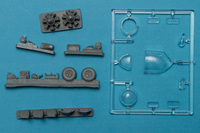 With the interior together, the rest of the assembly is pretty straightforward. The fuselage halves are a simple right/left split, and there is an option for the upper turret (although all four marking options do not have the turret). The windows and canopy will provide the only real challenge in building up the fuselage, as the windows are a press fit and the canopy has thin framing. Some careful glue work and masking will be essential here. The horizontal tailplanes are solid right and left pieces, and there are two options for the tailwheel (only one of which is used in this release).
With the interior together, the rest of the assembly is pretty straightforward. The fuselage halves are a simple right/left split, and there is an option for the upper turret (although all four marking options do not have the turret). The windows and canopy will provide the only real challenge in building up the fuselage, as the windows are a press fit and the canopy has thin framing. Some careful glue work and masking will be essential here. The horizontal tailplanes are solid right and left pieces, and there are two options for the tailwheel (only one of which is used in this release).
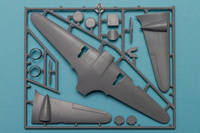 For the wings, these are split into three pieces. The one-piece lower wing incorporates a good piece of the fuselage, so hopefully the seamwork here will be minimal. As this is a short run kit, though, I would highly recommend test fitting often and making all the minor adjustments needed to minimize the amount of filler. The engines are nicely done in resin, and get sandwiched between a two-piece cowling. This can be challenging to keep round, so I would recommend assembling on a wooden dowel or something similar to ensure the shape remains round. The completed cowl then fits onto a one-piece front nacelle section, which then mates up to the wings. A somewhat complicated assembly, but when finished it should look pretty good.
For the wings, these are split into three pieces. The one-piece lower wing incorporates a good piece of the fuselage, so hopefully the seamwork here will be minimal. As this is a short run kit, though, I would highly recommend test fitting often and making all the minor adjustments needed to minimize the amount of filler. The engines are nicely done in resin, and get sandwiched between a two-piece cowling. This can be challenging to keep round, so I would recommend assembling on a wooden dowel or something similar to ensure the shape remains round. The completed cowl then fits onto a one-piece front nacelle section, which then mates up to the wings. A somewhat complicated assembly, but when finished it should look pretty good.
The landing gear is probably the most complicated assembly, as there are lots of variations here depending on versions, as well as the standard British twin strut main gear design. All of these parts will need some careful cleanup as there is a bit of flash present on just about all the strut pieces. Once all those little bits and pieces are together and in place, though, attention can turn to painting.
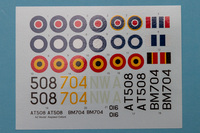 For colors and markings, this kit comes with several choices that offer something for just about everyone. There is one RAF example, two RAAF examples, and one Belgian example, all finished in different schemes. Starting with the RAF option, this plane is NW-A from No 286 Squadron in 1943. It's camouflaged in Dark Green and Dark Earth over Black, and has Sky codes.
For colors and markings, this kit comes with several choices that offer something for just about everyone. There is one RAF example, two RAAF examples, and one Belgian example, all finished in different schemes. Starting with the RAF option, this plane is NW-A from No 286 Squadron in 1943. It's camouflaged in Dark Green and Dark Earth over Black, and has Sky codes.
For the Australian options, the first is the boxtop scheme, BM704, from No 1 SFTS in 1943. This plane is also camouflaged in Dark Green and Dark Earth, but has yellow undersurfaces, broad yellow bands around the rear fuselage and outer wings, and yellow cowls. Coupled with the yellow fuselage numbers, this is a colorful scheme. The second RAAF option is for those who felt there wasn't enough yellow on the previous scheme: this one is overall yellow. It is AT508 from No 6 SFTS in October 1944, and has black numbers. The final option is the Belgian choice. This plane is aircraft 016, and it is finished in overall silver, with a broad orange band around the fuselage.
Conclusion
For those interested in adding a bit of back story to their collection of Lancasters and Halifaxes, this is a great little kit of a very popular RAF trainer. My thanks to AZ Model for the review sample.
